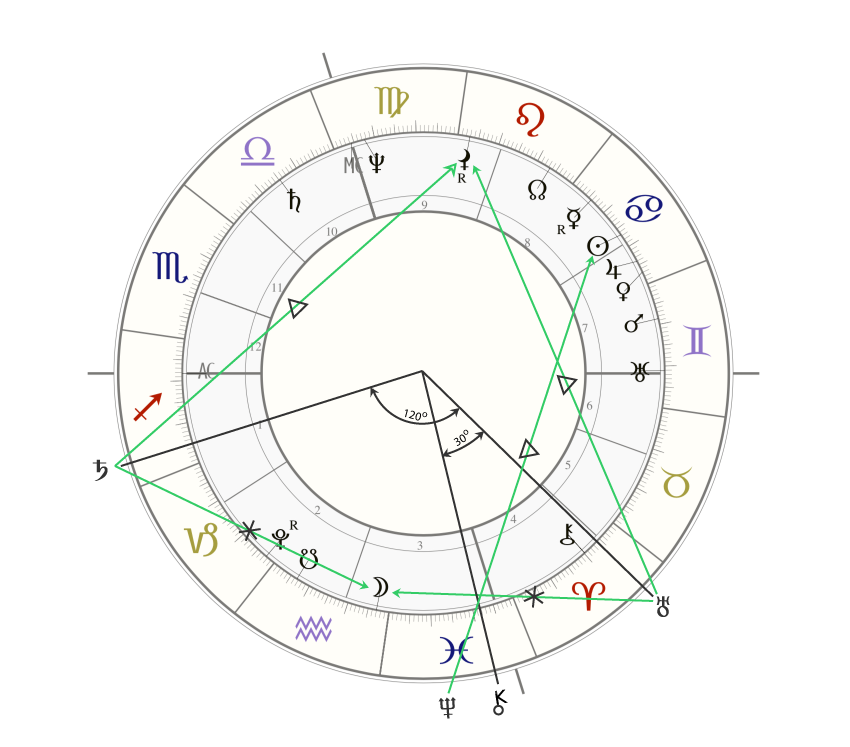Planetary Influences in 2017-18
This article has been written primarily for professional astrologers and might be too technical for some of my readers. If this is your case, go to U.S. Economy in 2019.
Uranus/Neptune Semi-Square
Uranus and Neptune entered their semi-square (45°) in June 2016 and will remain in or within 3° of this semi-square most of time through June 2020. Three previous Uranus/Neptune semi-squares that occurred since the founding of the United States coincided with recessions. Thus, Uranus/Neptune semi-square in 1800-02 coincided with the recession in 1802-04, the semi-square in 1844-48 coincided with two recessions, in 1845-46 and in 1847-48, and the semi-square in 1971-74 coincided with the recession in 1973-75. The influence of the current Uranus/Neptune semi-square (2016-20) has already brought about economic problems in many areas of the globe, including Brazil, Argentina, Russia, Ukraine, Turkey and Venezuela, while the rate of economic growth slowed down in EU and China. However, none of the major economies went into recession saved by the positive influence of Chiron/Uranus semi-sextile (30°).
Chiron/Uranus Semi-Sextile
Chiron is a hybrid between an asteroid and a dwarf planet. In spite of its small size, 17 times smaller than the Moon, it exerts an enormous influence on economy and the stock market. Apparently, when it comes to planetary influences, the size does not matter. Due to its irregular orbit, Chiron sometimes forms prolonged aspects with Uranus that last for up to 27 years.
The current Chiron/Uranus prolonged semi-sextile is responsible for one of the longest economic expansion in U.S. history. The influence of this aspect is especially powerful when Uranus and Chiron stay within 2° of this semi-sextile at least seven months a year, which has been taking place since 2009 and will continue through 2022.
Throughout the U.S. history, Chiron and Uranus formed only one prolonged Chiron/Uranus semi-sextile in 1922-28, which was mainly responsible for the second longest period of economic growth in the U.S., the Roaring Twenties in 1922-29. It appears that our current Chiron/Uranus semi-sextile has been producing the same positive effect on the U.S. economy as it did in the 1920s.
Helped by Jupiter and Saturn

Saturn/Uranus trine. From December 2016 through October 2018, Saturn and Uranus were in or close to a harmonious trine (120°). In about the same time, Saturn was also forming a quincunx (150°) to Chiron. Acting on their own, Saturn aspects to Chiron and Uranus are weak. In combination with Chiron/Uranus semi-sextile however, the harmonious aspects between the three created a resonance effect that overpowered the stressful influence of the Uranus/Neptune semi-square. The positive influence of these harmonious aspects was especially strong when Jupiter joined Saturn, Chiron and Uranus by forming simultaneous harmonious aspects to them all.
Jupiter’s harmonious aspects. From December 2016 through March 2017 and also in September-October 2017, Jupiter formed an opposition to Uranus, sextile to Saturn, and quincunx to Chiron. Then in October-November 2018, Jupiter formed a trine to Chiron and a quincunx to Uranus. A month later, it formed a semi-sextile to Saturn. These aspects of Jupiter also contributed to the U.S. economic expansion.
Blessed by Planetary Transits
So, in 2017 and most of 2018, the U.S. enjoyed robust economic growth, low unemployment not seen in decades, low inflation and a dramatic rise of home prices, while most of the world experienced a slowdown if not a recession. Why wasn’t the U.S. economy affected by this worldwide economic slowdown?
The U.S. was especially blessed by harmonious aspects from Saturn, Chiron and Uranus to the Moon in the U.S. chart. The Moon stands for the populace, the majority of the people. It rules the U.S. 8thHouse of Economy, Investment and the Stock Market. Apparently, these harmonious aspects were mainly responsible for the U.S. economic expansion.
In addition, Neptune formed a harmonious trine to the U.S. Sun also located in the 8thHouse of the U.S. chart providing another boost to the U.S. economy.
Unfortunately, the nature of the planetary influences will dramatically change in 2019. The harmonious planetary aspects discussed above will dissipate, while new stressful aspects will come into play causing an economic recession in 2019-21. (To read more go to U.S. Economy in 2019, Real Estate in 2019 and Planetary Influences in 2019.)
